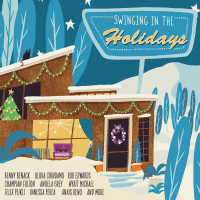Home » Jazz Musicians » Lena Horne
Lena Horne
Lena Horne, the beautiful, elegant, talented singer and actress has become a legend. Her strong sense of her own identity, of justice, and of dignity forced her to struggle against social adversity, and allowed her to triumph. Music is just a part of her story.
Lena Mary Calhoun Horne was born on June 30, 1917, in the Bedford-Stuyvesant neighborhood of Brooklyn, New York, her parents separated by the time she was three years old, and she lived for several years with her paternal grandparents. Her early life was nomadic: Horne's mother, who was a fairly unsuccessful stage performer, took the young Lena on the road with her, and they lived in various parts of the South before returning to Horne's grandparents' home in Brooklyn in 1931
Horne had early ambitions to be a performer--against the wishes of her family, who believed that she should aspire to greater heights. Nevertheless, Lena persisted, and in 1933 she began her first professional engagement, at the Cotton Club, the famed Harlem nightclub. She sang in the chorus, and though only sixteen years old, held her own among the older and more experienced cast members. She soon left high school to devote herself to her stage career.
In 1934 Horne had a small role in an all-black Broadway show called ‘Dance with Your Gods.’ The next year, she left the Cotton Club and began performing as the featured singer with Noble Sissle's Society Orchestra under the name "Helena Horne," which Sissle thought more glamorous than "Lena." In 1937 Horne quit her tour with the Sissle Orchestra to marry Louis Jones, a friend of her father. During this short and troubled marriage, Horne went to Hollywood to appear in an all-black film called ‘The Duke Is Tops.’ In 1939 she had a role in the musical revue ‘Blackbirds of 1939’ at the Hudson Theatre in New York City; it ran for only eight nights. Before her marriage to Jones ended in divorce, she had two children, Gail and Edwin ("Teddy").
Horne left Jones in 1940, taking a job as a singer with Charlie Barnet's band and going out on tour with him. Horne was the only black member of the ensemble, and the kind of racial discrimination she encountered from audiences, hotel managers, and others was so unsettling that she decided to quit the band. In 1941, she began performing at the Cafe Society Downtown, a club in New York City that catered to intellectuals and social activists, both black and white.At the Cafe Society, Horne learned about black history, politics, and culture and developed a new appreciation for her heritage. From this point on, Horne became a significant voice in the struggle for equality and justice for blacks in America.
Read moreTags
Save The Country - Songs Celebrating July 4th, New Releases, Birthday Shoutouts and More

by Mary Foster Conklin
This broadcast presents new releases from pianist Caili O'Doherty, bassist Michael Fiorino, the Nikos Chatzitsakos Tiny Big Band and a special digital reissue of Salome Bey's debut album, plus birthday shoutouts to Lena Horne, Tierney Sutton, Brandee Younger, Rhoda Scott, Madeline Eastman and Queen Esther, among others. Thanks for listening and please support the artists you hear by purchasing their music during this time of pandemic so they can continue to distract, comfort, provoke and inspire.Playlist Wayne Wallace ...
Continue ReadingStruttin With Some Barbeque - Celebrating July 4 with Louis Armstrong, Lena Horne and Friends

by Mary Foster Conklin
The Independence Day broadcast included new releases from Jimmy Heath featuring Cecile McLorin Salvant, vocalists Kathleen Grace, Melody Gardot and drummer Jake Reed with birthday shoutouts to Rhoda Scott, Lena Horne, Natalie Cressman and Louis Armstrong (yes we know, it's really in August but he claimed July 4 for his own and who are we to argue) . Thanks for listening and please support the artists you hear by purchasing their music during this time of lockdown. Playlist ...
Continue ReadingStormy Weather: The Life of Lena Horne

by C. Michael Bailey
Stormy Weather: The Life of Lena Horne James Gavin Hardcover; 608 pages ISBN: 0743271432 Simon and Schuster 2009...it just keeps rainin' all the time...
If James Gavin's biography of trumpeter Chet Baker, Deep In A Dream (Knopf, 2002), was a study of the slow motion, black hole implosion of a life into addiction and dissolution, then Stormy Weather: The Life of Lena Horne is a survey in the ...
Continue ReadingAn Evening with Lena Horne

by Jim Santella
Lena Horne An Evening with Lena Horne Blue Note 2006
The sentiment that comes embedded in Lena Horne's classy 1994 concert performance at the Supper Club in New York, is enough to carry the show all by itself. Her magnetic personality gives the cabaret performance a full charge of passion that's complemented by her convincing vocal expressions. She's a born communicator.
This performance was broadcast on the A&E television network ...
Continue ReadingLena Horne: Seasons of a Life

by Stephen Latessa
The recording studio is not always the best place for an artist to showcase their skills. Performers who have achieved their greatest success playing in front of an audience may in fact be unable to duplicate in the sterile confines of the studio that elusive talent that makes them so compelling on stage. Just as the craft of acting for the camera demands a different approach than acting in a theater, so too must a singer adjust when captured on ...
Continue ReadingLena Horne: Seasons of a Life

by Jim Santella
Over seventy for these performances and still swinging, Lena Horne sounds great. She's emotional and somewhat sentimental, but her performances always leave you with the feeling that you've just shared some quality time with an old friend.
Previously unissued, but recorded in 1994-2000 sessions that resulted in Classic Ellington, An Evening With Lena Horne, We'll Be Together Again, the Lulu on the Bridge soundtrack, and Being Myself, this Blue Note compilation carries vintage Lena Horne to its fullest. ...
Continue ReadingLena Horne: Being Myself

by AAJ Staff
"Come in and join the party," Lena calls, slapping her long fingers on an empty seat.
You best take her invitation, ‘cuz Ms. Horne knows of what she sings. Long-established as a jazz legend, Lena Horne continues her reign as queen of the blue note with her latest Blue Note release. In addition to touching up personal favorites such as "As Long As I Live" (which sparkles as brightly as when Horne performed it live for her classic concert collection ...
Continue ReadingLena Horne: Merry From Lena, 1966
Source:
JazzWax by Marc Myers
Once again, it's that time of year to induct a new entry into the JazzWax Vintage Holiday Album Hall of Fame. This year marks the Hall's 16th season and one of JazzWax's oldest annual traditions. This year's inductee is Merry From Lena, by Lena Horne. Released by United Artists in 1966, the album was produced by Ray Ellis (Billie Holiday's Lady in Satin) and orchestrated and conducted by Jack Parnell. The vocalist was in fine, swinging form. Now meet the ...
read more
Black History Month: Tribute to Lena Horne at Berklee Performance Center in Boston on February 22, Featuring Jo Thompson

Source:
MassJazz: Jazz in Massachusetts
Jazz musicians, dancers and professors —led by vocalist Jo Thompson—are gathering in Boston for a tribute to Lena Horne—a trailblazer in music,dance, film, human and civil rights. The event takes place on Tuesday, February 22, 2011, at the Berklee Performing Center, located at 136 Massachusetts Avenue in Boston's Back Bay. For directions click here. General admission is $10 and tickets can be ordered online. The show begins at 8:15 p.m. Along with this all-star big band concert, the tribute includes ...
read more
Turner Classic Movies to Pay Tribute to Singer-Actress Lena Horne Friday, May 21

Source:
CHC Network
Turner Classic Movies (TCM) will dedicate the Friday, May 21, primetime lineup to paying tribute to legendary singer-actress Lena Horne, who passed away yesterday at the age of 92.
The nights collection will feature three films with defining Horne performances. Also included is one of Hornes favorite films, the 1943 John Garfield drama The Fallen Sparrow.
8 p.m. The Duke is Tops (1938), Hornes film debut, featuring performances of the songs I Know You Remember and ...
read more
An Appreciation: Lena Horne

Source:
Michael Ricci
Toward the end of her very full life, Lena Horne suggested to a PBS interviewer that, after decades of struggling to define her image as an artist and a black woman, she finally had seized possession of her identity. “I don't have to be a symbol to anybody," said Horne, who died Sunday night in a New York hospital at the age of 92. “I no longer have to be a 'credit.' “ Americans born before 1960 will recognize Horne's ...
read more
Lena Horne Biography Tells of a Star Shaped by Rejection, Racism

Source:
Michael Ricci
'Stormy Weather: The Life of Lena Horne' by James Gavin reveals a woman whose life reflects the civil rights struggles of the times.
According to James Gavin's new biography, “Stormy Weather: The Life of Lena Horne," the legendary singer-actress was never comfortable being an icon. “As I say in the introduction of my book, icons are not allowed to be human beings," explains Gavin, a lifelong fan who interviewed Horne in 1994. “Once you step up on that pedestal . ...
read more
Lena Horne Singer and Civil Rights Activist Who Broke Barriers

Source:
Michael Ricci
Horne achieved a place in the pantheon of female jazz vocalists and broke ground in Hollywood as an African American star in the '40s. She also won acclaim on Broadway and as a cabaret performer.
On screen, on records and in nightclubs and concert halls, Horne was at home vocally with a wide musical range, from blues and jazz to the sophistication of Rodgers and Hart. “Stormy Weather" was Lena Horne's signature song as well as a chillingly apt metaphor ...
read more
Music Choice Airs Tribute to Lena Horne

Source:
Michael Ricci
Music Choice, the multi-platform video and music network, will celebrate the life of singer/dancer/actress LENA HORNE through May 18th on its SINGERS & SWING Audio Music Channel. Horne will be featured at the top of the hour during the Singers segment at 10am, 11am, 12 noon, 1pm, 6pm, 7pm, 8pm, 9pm 10pm, 2am, 3am, 4am, & 5am. In addition, the attached panel will be airing on the station as a tribute. Horne is one of the most popular African American ...
read more
Lena Horne, Singer and Actress, Dies at 92

Source:
Michael Ricci
Lena Horne, who was the first black performer to be signed to a long-term contract by a major Hollywood studio and who went on to achieve international fame as a singer, died on Sunday night at New York-Presbyterian/Weill Cornell Medical Center in New York. She was 92 and lived in Manhattan. Her death was announced by her son-in-law, Kevin Buckley. Ms. Horne might have become a major movie star, but she was born 50 years too early, and languished at ...
read more
Legendary Singer Lena Horne Dies

Source:
Michael Ricci
Lena Horne, the enchanting jazz singer and actress who reviled the bigotry that allowed her to entertain white audiences but not socialize with them, slowing her rise to Broadway superstardom, died Sunday. She was 92. Horne died at NewYork-Presbyterian Hospital, according to hospital spokeswoman Gloria Chin. Chin would not release any other details. Horne, whose striking beauty and magnetic sex appeal often overshadowed her sultry voice, was remarkably candid about the underlying reason for her success. “I was unique in ...
read more
Lena Horne Sings: The M-G-M Singles Collection on Hip-O Select

Source:
Michael Ricci
Hip-oSelect.com, under its Verve Select imprint, proudly announces the release of Lena Horne Sings: The M-G-M Singles Collection, a 16-track set that is just what the title claims: the first-ever retrospective of Ms. Hornes classic, classy singles on M-G-M Records, including her chart single Deed I Do, with most tracks on CD for the first time. James Gavin, author of the acclaimed biography Stormy Weather: The Life Of Lena Horne, co-produced the set and wrote its liner notes. (Stormy Weather ...
read more












































